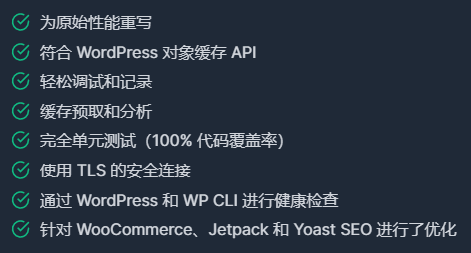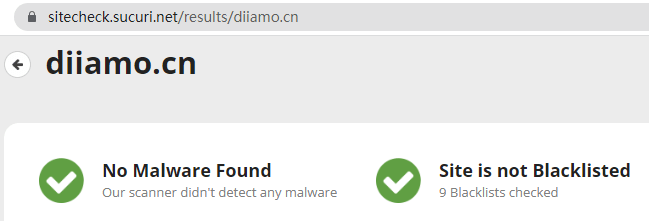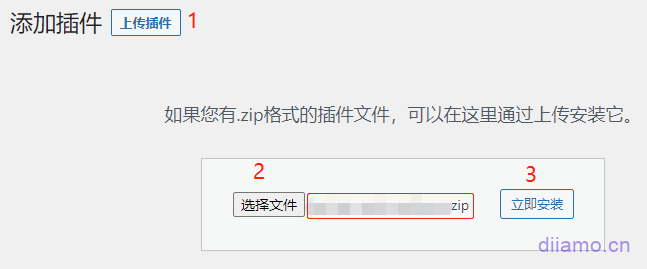Latest Object Cache Pro Download (Formerly known as Redis Object Cache Pro) This is an enterprise-grade object caching plugin designed for WordPress to improve site performance. Using Redis to cache objects in WordPress (such as posts, pages, comments, taxonomies, etc.) into memory reduces the number of database queries, which greatly improves page load speed,Responsiveness.
It also improves the speed of access to the backend, the frontend search function, filtering function and so on. Especially for Woocommerce sites that have to deal with a lot of dynamic content and high traffic, using a caching plugin like Redis Object Cache Pro is very beneficial.However, it may not be very helpful for static sites, which tend to involve few database queries, so the object store is of limited use.

Object Cache Pro is an object cache that can be used in conjunction with theNginx-FastcgiThe system cache as well as theWp Rocketand other page caching plug-ins to use together, because they cache the target as well as the role of different levels. However, the use of multiple caches together need to be configured, otherwise it is easy to duplicate the cache resulting in slow speed or conflict.
It can also cache some background operations to speed up background access. If the background made some changes did not take effect in time, refresh the Redis cache can be.
Use this plugin to achieve Redis object cache can no longer use Mamcached object cache , the site can only use an object cache . After the use of object caching, there is no need to use the database cache, easy to have conflicts.
What's the difference between the free version and the paid version?
The Pro version further reduces the number of Redis requests and memory footprint through technologies such as Bulk Key Prefetching and igbinary serialization, which again improves theoretical performance by about 151 TP5T-201 TP5T. Theoretical performance is again improved by about 151 TP5T-201 TP5T, but this optimization is not obvious for sites with fewer visits and less data.
Pro version is deeply optimized for dynamic content of WooCommerce and other plug-ins, automatically identifying high-frequency queries and preloading them, and avoiding cache-penetration problems if the site contains real-time inventory display or dynamic forms.
Memory compression:Supporting LZ4/ZSTD algorithm, the memory occupation is reduced by 50%, which is suitable for the scenario of long-term operation and gradually increasing data volume.
Stability Guarantee:Built-in health check and automatic failover to avoid caching service crashes that can bring down websites.
Debugging Tools:Provides real-time hit rate monitoring for troubleshooting cache failures
What is a GPL licensed plugin
This plugin is a GPL licensed product and is safe and legal. Click to learn what isGPL AgreementClick to learnWordPress official website about GPL. Simply put using the GPL license plugin/theme source code open source sharing, can be legally free to change, use, distribution.
The company that owns the plugin/theme mentioned in the title of this item is not affiliated with us in any way, and the company has not licensed its products or brands to us. This product is a distribution of the plugin/theme mentioned in the title, created by a third party company/developer and redistributed by us under the terms of the General Public License (GPL).
We use the plugin/theme name for the sole purpose of identifying the plugin/theme on which this product is based, with the intention of helping users better understand the functionality and possible application scenarios of our product, and in no way to impersonate or mislead. This product is sold under and respects the terms of the GPL license agreement and ensures that users are aware that they are acquiring a distribution of the plugin/theme based on an open source license. They are allowed to view, modify and redistribute the software to promote its free use and development.
Verified by Security Antivirus
Directly from foreign formal channels to buy, do not modify the source code. All plug-ins we use to build their own sites, used in a number of sites, safe, stable and reliable.Are you worried that the plugin is not secure? Check this articel:Is WordPress Cracked Plugins/Themes (Green, GPL, Nulled) Safe?.
- ByVirustotal Antivirus Verification;.
- ByWordfenceSource code review.
- BySucuriSecurity antivirus scanning.

Object Cache Pro Update Methods/Records
General new version out within 24 hours of this site will be updated, then please visit this page directly to download the new version of the installation package upload update, the product title will be written on the latest version number. Can only be updated by uploading the installation package, mind not to shoot, if you want to update online please support the original version to go to the official website of the plug-in to buy.
Click to view the update history of this plugin (Changelog).
Object Cache Pro Download Terms of Purchase
This site plug-in purchased from foreign sites, the purchase price is4.99 USD/pcThe price is 2 years. Diamo uniform selling price of 19 yuan / a, spend a lot of effort to produce the use of tutorials + provide manual Q&A service, absolutely value for money.
Plug-in for learning and research purposes only, virtual products are reproducible, once sold no refund, please move to the detailsTerms of Service. Please log in before purchasing, and refresh the page after purchase to get permission to download the plug-in.
Diamo for the purchase of users to provide after-sales service, plug-in use any questions please leave a message in the comments below, there will be answers to questions.
Installation / Activation Method
Directly install the zip installation package purchased and downloaded from this site, and enable it after installation.
After installing, or after updating the version, you may see the Outdated prompt as shown below, just click the "Update Drop-in" button to update it.

Installation method 1: Upload and install
Find and click on "Plugins" > "Install Plugins" in the left menu bar of the website background, then click on "Upload Plugin" in the upper left corner, upload the downloaded zip installation package and click on "Install Now", after installation, click"Enable Plugin"Complete the installation.

Installation method 2.FTP installation
Unzip the plug-in package, put the unzippedFoldersUpload it to the plugins directory (xxx.com/wp-content/plugins).
Find and click on "Plugins" > "Installed Plugins" in the left menu bar of the website background, find the plugin in the list of plugins, and click "Enable".

Object Cache Pro Configuration Enablement Method
Note: If prompted with a new version of the update, please do not directly update online in the background, it will lead to plug-in abnormal. Please download the new version on this page to override the installation of the update, if the installation shows that there are two of the same plug-in, disable the uninstallation of the older version on the line.
The server PHP needs to have the Redis extension installed firstThen copy and paste the following configuration code (choose one of the two codes) into the root directory of the website wp-config.php, go back to the plugin settings page and click "Enable Cache" to enable it.

Note that all the lines of the following code have a comma at the end of the parameter setting line , . If you can see the request data in the Dashboard Object Cache widget, the configuration was successful.
Small and medium-sized websites, especially foreign trade websites, use the following configuration.
define('WP_REDIS_CONFIG', [
'token' => 'e279430effe043b8c17d3f3c751c4c0846bc70c97f0eaaea766b4079001c',
'host' => '127.0.0.1',
'port' => 6379,
//'password' => 'xxx',
'database' => 0, // 第一个网站为0,第二个为1,以此类推
'maxttl' => 3600 * 24 * 7, // 7 days
'timeout' => 1.0,
'read_timeout' => 1.0,
'prefetch' => true,
'split_alloptions' => true,
'strict' => true,
'debug' => false,
]);
define('WP_REDIS_DISABLED', false);'password' => 'xxx',: the role is to set the Redis password, the configuration code does not add the Redis password by default. If your Redis has a password, put the password in line 5 of the code.xxxReplace it with the password and delete the 'password' in front of the//, the code will take effect.
For high-performance sites and large sites, use the following configuration.Caution.'compression' => 'zstd' and 'serializer' => 'igbinary' These 2 features require the zstd and igbinaryPHP extensions to be installed first and restarted after installation.
If you add the code after the site prompts "Error establishing a Redis connection", delete the 2 content, save and restart PHP and Redis can be restored to normal.
Pagoda Panel sometimes seems to have compatibility problems with these 2 extensions, enabling them will result in the website not being able to open, so these 2 features are not recommended to be enabled in websites that use Pagoda Panel.
define('WP_REDIS_CONFIG', [
'token' => 'e279430effe043b8c17d3f3c751c4c0846bc70c97f0eaaea766b4079001c',
'host' => '127.0.0.1',
'port' => 6379,
//'password' => 'xxx',
'database' => 0, // 第一个网站为0,第二个为1,以此类推
'timeout' => 0.5,
'read_timeout' => 0.5,
'retry_interval' => 10,
'retries' => 3,
'backoff' => 'smart',
'compression' => 'zstd', // `zstd` compresses smaller, `lz4` compresses faster
'serializer' => 'igbinary',
'async_flush' => true,
'split_alloptions' => true,
'prefetch' => true,
'strict' => true,
'debug' => false,
'save_commands' => false,
]);
define('WP_REDIS_DISABLED', getenv('WP_REDIS_DISABLED') ?: false);'serializer' => 'igbinary': can improve the processing speed of cached data and reduce the memory usage of cached data. However, igbinary compatibility is almost close, and site anomalies may occur after enabling it.
'compression' => 'zstd': set compression algorithm, further less data size. However, zstd compatibility is not so good, and there may be site anomalies after enabling it.
The above 2 settings should be paid special attention to, some servers may not support, will lead to abnormal website. If you can not enable or abnormal, edit the code to delete the above two lines to restart PHP and Redis on the line.
host' => Specify the Redis server address, or '127.0.0.1' if it is on the same host as the WEB server.
'port' => Redis connection port, the default is 6379, if you change the default port in Redis, then this should follow.
'database' => Specify the Redis database number. If there are multiple sites using the same Redis server, you need to specify a different database number for each site. The default is 0. The maximum number of numbers supported depends on the number of databases supported by the Redis server, which by default supports 16.
Tip: If you have more than one website inside your server using this plugin, you need to set 'database' => 0 for the first website, 'database' => 1 for the second, and so on. Otherwise the site will be abnormal.
'username' => the username for connecting to Redis, it is not required if Redis is not set up for login authentication. Example usage: 'username' => 'abc',
'password' => Password for connecting to Redis, used as above. If Redis does not set a password, there is no need to use it.
'prefix' => Similar to WP's $able_prefix variable, which adds a prefix to all database table names. Example: 'prefix' => 'mysitename',
'maxttl' => enforce "maximum time to live" in seconds for all new cache keys. Example: 'maxttl' => 3600 * 24, // 24 hours
'timeout' => connection timeout with Redis, in seconds, supports decimals. Example: 'timeout' => 1.5,
'read_timeout' => read timeout in seconds, decimals supported, same usage as above.
'retry_interval' => retry interval, in milliseconds, integer supported. Example: 'retry_interval' => 300,
'retries' => Set the number of retries for a failed connection, integer type.
'backoff' => 'default', when using the retry configuration, the default backoff configuration will be used, which includes: a de-correlated jitter algorithm, a base of 500 ms for compensation calculation, and a compensation time limit of 750 ms
'shared' => true, sets whether the Redis server/cluster is shared or dedicated. This affects how memory and key counts are displayed.
'async_flush' => true, Asynchronous flush was introduced in Redis 4.0 and can be enabled using this async_flush option. It allows deleting a large number of Keys in the background without blocking the server.
'prefetch' => true, When prefetching is enabled, the requested cached keys are stored on a per-request basis and are loaded in bulk by group early in successive requests. The list of prefetchable keys is updated on each request to keep it up to date.
'split_alloptions' => true: Store alloptions keys as a hash in Redis instead of a single serialized string. This can improve performance and reduce memory usage.
The above are some common parameters, basically meet most of the website needs, such as the need to understand all the parameters please checkOfficial Documents.
For advanced features such as compression and asynchronous refresh, please seeConfiguration OptionsThe full list of To connect to a Redis cluster or use replication, seeConnection Guide.
After installing the code, tap Enable Cache ↓ on the plugin page.

After installing, or after updating the version, you may see the Outdated prompt as shown below, just click the "Update Drop-in" button to update it.

Below is a screenshot after enabling caching for a while, it can successfully display the data and cache size. Click on "Display Options" in the upper right corner to choose which data blocks to display.
Hits. The number of requests cached in memory.
Misses. The number of requests that have not been cached. Uncached Hits. The number of requests cached in memory.
Hits-to-Misses Ratio. The ratio between requests that have been cached and requests that have not been cached, with larger values indicating better caching.
Successful Key Lookups. The number of successful Redis key lookups.
Failed Key Lookups. The number of failed Redis key lookups.
Hits-to-Misses Ratio. The ratio between hits and misses for Redis key lookups, with larger values indicating better caching.
Cache Reads. The number of reads from the cache.
Datastore Writes. The number of writes to the datastore indicating that the cache is expired or needs to be updated.
Datastore Reads. The number of reads from the data store.
Cache Writes. The number of writes to the cache.
WordPress Render Time. The average time (in milliseconds) it takes WordPress to render a request.
Datastore Response Time. The average time (in milliseconds) to wait for a datastore response.
Memory Allocated. The amount of memory currently allocated.
Used Memory. The amount of memory used.
Memory Ratio. Displays the ratio between allocated memory and the maximum memory that can be allocated.
Average Time Waiting for Datastore Response. The average time (in milliseconds) to wait for a datastore response.
Commands Processed per Second. The number of commands processed, with the value indicating that caching is more effective.
Common Problems & Solutions
For more tutorials and FAQs, please move toOfficial Documents. Here are a few common questions that have been reported back by Diamo users.
PHP cache was exported and reported an error
If it's a VPS server with multiple sites, different sitesneedUse different databases and different database prefixesneedset up differently. Click on theView Details.
"Error establishing a Redis connection" after adding configuration
This problem occurs because some configurations in your configuration code are not compatible with the host. Instead, use the following configuration code, add and save it, and then restart the Redis service of the VPS host, shared and managed hosts do not need to restart.
define('WP_REDIS_CONFIG', [
'token' => 'e279430effe043b8c17d3f3c751c4c0846bc70c97f0eaaea766b4079001c',
'host' => '127.0.0.1',
'port' => 6379,
'database' => 0, // 第一个网站为0,第二个为1,以此类推
'maxttl' => 3600 * 24 * 7, // 7 days
'timeout' => 1.0,
'read_timeout' => 1.0,
'prefetch' => true,
'split_alloptions' => true,
'strict' => true,
'debug' => false,
]);
define('WP_REDIS_DISABLED', false);Hosts like SiteGround don't support Redis or have limited functionality to use the Object Cache Pro plugin, and can only use Memcached instead.
"Redis uses the noeviction policy" in Site Health.
In some versions (e.g. 1.24.2), the following message will be displayed in the site health: "Redis uses the noeviction policy", just ignore it, it's not bad.
This tip means that if Redis consumes the allocated free memory (not enough memory to use), it may cause the site to crash, and you need to set the cache expiration time so that it will periodically and automatically clean up the expired cache to free up space.

In fact, if you activate the code according to our tutorial above, you will add the red box code in the picture below, this is to set the cache expiration time. At this time, the above error message is a false alarm, you can ignore.
Even if you don't add the red box code, it has no effect. A small and medium-sized website Redis object cache memory is generally only a few tens of MB, up to 200MB. Pagoda default Redis available memory for the server memory capacity, generally a few G.
Multiple sites with low server configurations, pay attention to total memory usage, expand capacity appropriately, etc.

In the Home Dashboard widget, the red box position in the image below will show how much Redis memory is available.




